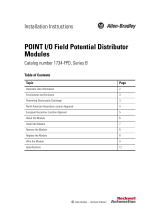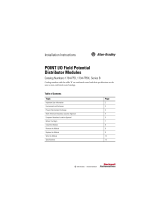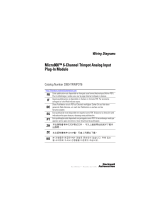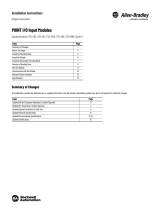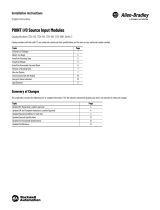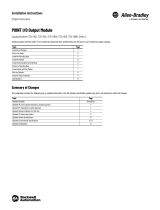Page is loading ...

Installation Instructions
POINT I/O 120V AC Input Module
Catalog numbers 1734-IA2, 1734-IA4, Series C
Table of Contents
Topic Page
Important User Information 2
Environment and Enclosure 3
Preventing Electrostatic Discharge 3
North American Hazardous Location Approval 4
European Hazardous Location Approval 5
Before You Begin 6
Install the Mounting Base 8
Install the Module 9
Install the Removable Terminal Block 11
Remove a Mounting Base 13
Wire the Module 14
Communicate with Your Module 17
Interpret Status Indicators 18
Specifications 20

2 POINT I/O 120V AC Input Module
Publication 1734-IN010E-EN-E - August 2016
Important User Information
Solid-state equipment has operational characteristics differing from those of electromechanical
equipment. Safety Guidelines for the Application, Installation and Maintenance of Solid State Controls
(Publication SGI-1.1
available from your local Rockwell Automation sales office or online at
http://www.rockwellautomation.com/literature/
) describes some important differences between
solid-state equipment and hard-wired electromechanical devices. Because of this difference, and also
because of the wide variety of uses for solid-state equipment, all persons responsible for applying this
equipment must satisfy themselves that each intended application of this equipment is acceptable.
In no event will Rockwell Automation, Inc. be responsible or liable for indirect or consequential damages
resulting from the use or application of this equipment.
The examples and diagrams in this manual are included solely for illustrative purposes. Because of the
many variables and requirements associated with any particular installation, Rockwell Automation, Inc.
cannot assume responsibility or liability for actual use based on the examples and diagrams.
No patent liability is assumed by Rockwell Automation, Inc. with respect to use of information, circuits,
equipment, or software described in this manual.
Reproduction of the contents of this manual, in whole or in part, without written permission of Rockwell
Automation, Inc., is prohibited.
Throughout this manual, when necessary, we use notes to make you aware of safety considerations.
WARNING: Identifies information about practices or circumstances that can cause an
explosion in a hazardous environment, which may lead to personal injury or death,
property damage, or economic loss.
ATTENTION: Identifies information about practices or circumstances that can lead to
personal injury or death, property damage, or economic loss. Attentions help you
identify a hazard, avoid a hazard and recognize the consequences.
SHOCK HAZARD: Labels may be on or inside the equipment (for example, drive or
motor) to alert people that dangerous voltage may be present.
BURN HAZARD: Labels may be on or inside the equipment (for example, drive or
motor) to alert people that surfaces may reach dangerous temperatures.
IMPORTANT Identifies information that is critical for successful application and understanding of
the product.

POINT I/O 120V AC Input Module 3
Publication 1734-IN010E-EN-E - August 2016
Environment and Enclosure
Preventing Electrostatic Discharge
ATTENTION: This equipment is intended for use in a Pollution Degree 2
industrial environment, in overvoltage Category II applications (as defined in IEC
publication 60664-1), at altitudes up to 2000 meters (6562 ft) without derating.
This equipment is considered Group 1, Class A industrial equipment according
to IEC/CISPR Publication 11. Without appropriate precautions, there may be
potential difficulties ensuring electromagnetic compatibility in other
environments due to conducted as well as radiated disturbance.
This equipment is supplied as open-type equipment. It must be mounted within
an enclosure that is suitably designed for those specific environmental
conditions that will be present and appropriately designed to prevent personal
injury resulting from accessibility to live parts. The enclosure must have suitable
flame-retardant properties to prevent or minimize the spread of flame,
complying with a flame spread rating of 5VA, V2, V1, V0 (or equivalent) if
non-metallic. The interior of the enclosure must be accessible only by the use of
a tool. Subsequent sections of this publication may contain additional
information regarding specific enclosure type ratings that are required to
comply with certain product safety certifications.
In addition to this publication, see:
• Industrial Automation Wiring and Grounding Guidelines, for additional
installation requirements, Allen-Bradley publication 1770-IN041
.
• NEMA Standards publication 250 and IEC publication 60529, as applicable,
for explanations of the degrees of protection provided by different types of
enclosure.
ATTENTION: This equipment is sensitive to electrostatic discharge, which can
cause internal damage and affect normal operation. Follow these guidelines
when you handle this equipment:
• Touch a grounded object to discharge potential static.
• Wear an approved grounding wriststrap.
• Do not touch connectors or pins on component boards.
• Do not touch circuit components inside the equipment.
• Use a static-safe workstation, if available.
• Store the equipment in appropriate static-safe packaging when not in use.

4 POINT I/O 120V AC Input Module
Publication 1734-IN010E-EN-E - August 2016
North American Hazardous Location Approval
The following information applies when
operating this equipment in hazardous
locations:
Informations sur l’utilisation de cet
équipement en environnements dangereux:
Products marked "CL I, DIV 2, GP A, B, C, D" are suitable for
use in Class I Division 2 Groups A, B, C, D, Hazardous
Locations and nonhazardous locations only. Each product is
supplied with markings on the rating nameplate indicating
the hazardous location temperature code. When combining
products within a system, the most adverse temperature code
(lowest "T" number) may be used to help determine the
overall temperature code of the system. Combinations of
equipment in your system are subject to investigation by the
local Authority Having Jurisdiction at the time of installation.
Les produits marqués "CL I, DIV 2, GP A, B, C, D" ne
conviennent qu'à une utilisation en environnements de
Classe I Division 2 Groupes A, B, C, D dangereux et non
dangereux. Chaque produit est livré avec des marquages
sur sa plaque d'identification qui indiquent le code de
température pour les environnements dangereux. Lorsque
plusieurs produits sont combinés dans un système, le code
de température le plus défavorable (code de température le
plus faible) peut être utilisé pour déterminer le code de
température global du système. Les combinaisons
d'équipements dans le système sont sujettes à inspection
par les autorités locales qualifiées au moment de
l'installation.
EXPLOSION HAZARD
• Do not disconnect equipment unless power
has been removed or the area is known to be
nonhazardous.
• Do not disconnect connections to this
equipment unless power has been removed
or the area is known to be nonhazardous.
Secure any external connections that mate
to this equipment by using screws, sliding
latches, threaded connectors, or other
means provided with this product.
• Substitution of components may impair
suitability for Class I, Division 2.
• If this product contains batteries, they must
only be changed in an area known to be
nonhazardous.
RISQUE D’EXPLOSION
• Couper le courant ou s'assurer que
l'environnement est classé non dangereux
avant de débrancher l'équipement.
• Couper le courant ou s'assurer que
l'environnement est classé non dangereux
avant de débrancher les connecteurs.
Fixer tous les connecteurs externes reliés
à cet équipement à l'aide de vis, loquets
coulissants, connecteurs filetés ou autres
moyens fournis avec ce produit.
• La substitution de composants peut
rendre cet équipement inadapté à une
utilisation en environnement de Classe I,
Division 2.
• S'assurer que l'environnement est classé
non dangereux avant de changer les piles.

POINT I/O 120V AC Input Module 5
Publication 1734-IN010E-EN-E - August 2016
European Hazardous Location Approval
The following applies when the product bears the Ex Marking
This equipment is intended for use in potentially explosive atmospheres as defined by
European Union Directive 94/9/EC.
DEMKO certifies that this equipment has been found to comply with the Essential Health
and Safety Requirements relating to the design and construction of Category 3 equipment
intended for use in Zone 2 potentially explosive atmospheres, given in Annex II to this
Directive.
Compliance with the Essential Health and Safety Requirements has been assured by
compliance with EN 60079-0:2012+A11:2013, EN 60079-15:2010, reference certificate
number DEMKO 04ATEX0330347X.
WARNING: This equipment shall be mounted in an ATEX certified enclosure
with a minimum ingress protection rating of at least IP54 (as defined in
IEC60529) and used in an environment of not more than Pollution Degree 2
(as defined in IEC 60664-1) when applied in Zone 2 environments. The
enclosure must utilize a tool removable cover or door.
WARNING: This equipment shall be used within its specified ratings
defined by Rockwell Automation.
WARNING: Provision shall be made to prevent the rated voltage from being
exceeded by transient disturbances of more than 140% of the rated voltage
when applied in Zone 2 environments.
WARNING: Secure any external connections that mate to this equipment by
using screws, sliding latches, threaded connectors, or other means provided
with this product.
WARNING: Do not disconnect equipment unless power has been removed
or the area is known to be nonhazardous.
ATTENTION: This equipment is not resistant to sunlight or other sources of
UV radiation.

6 POINT I/O 120V AC Input Module
Publication 1734-IN010E-EN-E - August 2016
Before You Begin
You can use these POINT I/O™ 120V AC Input modules with DeviceNet and
PROFIBUS adapters. If you are using RSLogix 5000 software, version 11 or higher, you
can also use the Series C modules with ControlNet and Ethernet adapters.
Use this diagram to identify the external features of the module.
Note: The wiring base assembly consists of one of the following:
• 1734-TB or 1734-TBS POINT I/O two-piece terminal base, which includes the
1734-RTB Removable Terminal Block
• 1734-TOP or 1734-TOPS POINT I/O single-piece terminal base
POINT I/O 120V AC Input Module
Description Description
1 Module locking mechanism 6 Mounting base – 1734-TB, 1734-TBS
2 Slide-in writable label 7 Interlocking side pieces
3 Insertable I/O module 8 Mechanical keying (orange)
4 Removable Terminal Block (RTB) handle 9 DIN rail locking screw (orange)
5 RTB with screw or spring clamp 10 Module wiring diagram
120VAC
Input
Module
Status
Network
Status
NODE:
0
1
1
10
9
8
7
2
3
4
5
6
45713

POINT I/O 120V AC Input Module 7
Publication 1734-IN010E-EN-E - August 2016
Description Description
1 Module locking mechanism 6 Interlocking side pieces
2 Slide-in writable label 7 Mechanical keying (orange)
3 Insertable I/O module 8 DIN rail locking screw (orange)
4 Handle 9 Module wiring diagram
5 One-piece terminal base with screw or
spring clamp – 1734-TOP, 1734-TOPS
1
9
8
7
6
2
3
4
5
45712

8 POINT I/O 120V AC Input Module
Publication 1734-IN010E-EN-E - August 2016
Install the Mounting Base
To install the mounting base on the DIN rail (Allen-Bradley part number 199-DR1;
46277-3; EN50022), proceed as follows:
1. Position the mounting base vertically above the installed units (adapter, power
supply or existing module).
2. Slide the mounting base down allowing the interlocking side pieces to engage the
adjacent module or adapter.
3. Press firmly to seat the mounting base on the DIN rail. The mounting base snaps
into place.
ATTENTION: This product is grounded through the DIN rail to chassis ground.
Use zinc plated yellow-chromate steel DIN rail to assure proper grounding. The
use of other DIN rail materials (for example, aluminum or plastic) that can
corrode, oxidize, or are poor conductors, can result in improper or intermittent
grounding. Secure DIN rail to mounting surface approximately every 200 mm
(7.8 in.) and use end-anchors appropriately.
31586

POINT I/O 120V AC Input Module 9
Publication 1734-IN010E-EN-E - August 2016
Install the Module
The module can be installed before or after base installation. Make sure that the mounting
base is correctly keyed before installing the module into the mounting base. In addition,
make sure the mounting base locking screw is positioned horizontal referenced to the base.
WARNING: When you insert or remove the module while backplane power is
on, an electrical arc can occur. This could cause an explosion in hazardous
location installations.
Be sure that power is removed or the area is nonhazardous before proceeding.
Repeated electrical arcing causes excessive wear to contacts on both the
module and its mating connector. Worn contacts may create electrical
resistance that can affect module operation.
Turn the keyswitch to align the
number with the notch.
Notch position 3 is shown here.
Make sure the DIN-rail locking
screw is in the horizontal position.
1734-TB base
45696

10 POINT I/O 120V AC Input Module
Publication 1734-IN010E-EN-E - August 2016
1. Using a bladed screwdriver, rotate the keyswitch on the mounting base clockwise
until the number required for the type of module being installed aligns with the
notch in the base.
2. Make certain the DIN rail locking screw is in the horizontal position. You cannot
insert the module if the locking mechanism is unlocked.
3. Insert the module straight down into the mounting base and press to secure. The
module locks into place.
Turn the keyswitch to align the
number with the notch.
Notch position 1 is shown here.
Make sure the DIN-rail locking
screw is in the horizontal position.
1734-TOP base
45697

POINT I/O 120V AC Input Module 11
Publication 1734-IN010E-EN-E - August 2016
Install the Removable Terminal Block
A Removable Terminal Block (RTB) is supplied with your wiring base assembly. To
remove, pull up on the RTB handle. This allows the mounting base to be removed and
replaced as necessary without removing any of the wiring. To reinsert the Removable
Terminal Block, proceed as follows:
1. Insert the end opposite the handle into the base unit. This end has a curved
section that engages with the wiring base.
2. Rotate the terminal block into the wiring base until it locks itself in place.
3. If an I/O module is installed, snap the RTB handle into place on the module.
WARNING: When you connect or disconnect the Removable Terminal Block
(RTB) with field side power applied, an electrical arc can occur. This could cause
an explosion in hazardous location installations.
Be sure that power is removed or the area is nonhazardous before proceeding.
1
2
0
V
A
C
In
p
u
t
M
o
d
u
le
S
ta
tu
s
N
e
t
w
o
r
k
S
ta
tu
s
N
O
D
E
:
0
1
Hook the RTB end into
the mounting base end
and rotate until it locks
into place.
45716
Insert the module
straight down into
the mounting base

12 POINT I/O 120V AC Input Module
Publication 1734-IN010E-EN-E - August 2016
WARNING: For 1734-RTBS and 1734-RTB3S, to latch and un-latch the wire,
insert a bladed screwdriver (catalog number 1492-N90 – 3 mm diameter blade)
into the opening at approximately 73° (blade surface is parallel with top surface
of the opening) and push up gently.
WARNING: For 1734-TOPS and 1734-TOP3S, to latch and un-latch the wire,
insert a bladed screwdriver (catalog number 1492-N90 – 3 mm diameter) into
the opening at approximately 97° (blade surface is parallel with top surface of
the opening) and press in (do not push up or down).
73° 85°
97°

POINT I/O 120V AC Input Module 13
Publication 1734-IN010E-EN-E - August 2016
Remove a Mounting Base
To remove a mounting base, you must remove any installed module, and the module
installed in the base to the right. Remove the Removable Terminal Block, if wired.
1. Unlatch the RTB handle on the I/O module.
2. Pull on the RTB handle to remove the Removable Terminal Block.
3. Press on the module lock on the top of the module.
4. Pull on the I/O module to remove from the base.
5. Repeat steps 1, 2, 3 and 4 for the module to the right.
6. Use a small bladed screwdriver to rotate the orange base locking screw to a
vertical position. This releases the locking mechanism.
7. Lift straight up to remove.

14 POINT I/O 120V AC Input Module
Publication 1734-IN010E-EN-E - August 2016
Wire the Module
WARNING: If you connect or disconnect wiring while the field-side power is
on, an electrical arc can occur. This could cause an explosion in hazardous
location installations. Be sure that power is removed or the area is
nonhazardous before proceeding.
120VAC
Input
Module
Status
Network
Status
1734
IA2
0
1
NODE:
Module status
Network status
Status of Input 0
Status of Input 1
Channel 0
connection
Channel 2
connection
Channel 1
connection
No connection
L2/N L1
L1 L1
L2/N = 120V AC return
L1 = 120V AC supply
Module status
Network status
Status of Input 0
Status of Input 1
Status of Input 2
Status of Input 3
Channel 0
connection
No connection
L2/N
L1
1734-IA2 1734-IA4
120VAC
Input
Module
Status
Network
Status
1734
IA4
0
1
NODE:
2
3
Channel 1
connection
Channel 3
connection
L1
L1
45715 45714

POINT I/O 120V AC Input Module 15
Publication 1734-IN010E-EN-E - August 2016
1734-IA2
Channel Input terminal Return Supply
0046
1157
Module power is supplied from the internal power bus.
Prox
Ch 0
Ch 1
NC
L2/N
L1
L1
L2/N
NC
Prox
Three-wireTwo-wire
3
5
7
0
1
2
4
6
Ch 0 = Channel 0 input
Ch 1 = Channel 1 input
NC = No connection
L2/N = 120V AC neutral
L1 = 120V AC

16 POINT I/O 120V AC Input Module
Publication 1734-IN010E-EN-E - August 2016
1734-IA4
Channel Input terminal Power
004
115
226
337
Module power is supplied from the internal power bus.
ProxProx
Ch 0
Ch 1
Ch 2
L1
L1
L1
L1
Ch 3
Prox
L2/N
L2/N
3
5
7
0
1
2
4
6
Ch 0 = Channel 0 input
Ch 1 = Channel 1 input
Ch 2 = Channel 2 input
Prox
Ch 3 = Channel 3 input
L2/N = 120V AC neutral
L1 = 120V AC

POINT I/O 120V AC Input Module 17
Publication 1734-IN010E-EN-E - August 2016
Communicate with Your Module
I/O messages are sent to (consumed) and received from (produced) the POINT I/O
modules. These messages are mapped onto the processor’s memory.
The POINT I/O output module produces 1 Byte of input data (scanner Tx) (state). It
does not consume data (scanner Rx).
Default Data Map for 1734-IA2
Message size: 1 Byte
76543210
Produces (scanner Rx) Ch1 Ch0
Consumes (scanner Tx) No consumed data
Where: Ch0 = Channel 0, Ch1 = Channel 1, 0 = Off, 1 = On
Default Data Map for 1734-IA4
Message size: 1 Byte
76543210
Produces (scanner Rx) Ch3 Ch2 Ch1 Ch0
Consumes (scanner Tx) No consumed data
Where: Ch0 = Channel 0, Ch1= Channel 1, Ch2 = Channel 2, Ch3 = Channel 3, 0 = Off, 1= On

18 POINT I/O 120V AC Input Module
Publication 1734-IN010E-EN-E - August 2016
Interpret Status Indicators
Refer to the following diagram and table for information on how to interpret the
status indicators.
Indicator Status for Modules
Status Description Recommended Action
Module status Off No power applied to device. Apply power to device.
Green Device operating normally. None.
Flashing green Device needs commissioning
due to missing, incomplete, or
incorrect configuration.
Configure device properly.
Flashing red Recoverable fault. Cycle power to device. If
condition persists, replace
device.
Red Unrecoverable fault – may
require device replacement.
Replace device.
Flashing red/green Device is in self-test mode. None.
1734-IA2
44214
Module status
Network status
Status of Input 1
1734-IA4
Status of Input 2
Status of Input 3
44215
Module status
Network status
Status of Input 0
Status of Input 1
Status of Input 0

POINT I/O 120V AC Input Module 19
Publication 1734-IN010E-EN-E - August 2016
Indicator Status for Modules
Status Description Recommended Action
Network status Off Device is not online:
- Device has not completed
dup_MAC-id test.
- Device not powered – check
module status indicator.
Apply power to device, wait for
dup_MAC-id test to complete,
and correct as needed.
Flashing green Device is online but has no
connections in the established
state.
None – device is in idle or
program mode.
Green Device is online and has
connections in the established
state.
None.
Flashing red One or more I/O connections are
in timed-out state.
Check for I/O module failure,
and correct as needed.
Red Critical link failure – failed
communication device. Device
detected error that prevents it
from communicating on the
network.
Verify that adapter and terminal
bases are properly installed, and
reinstall as needed.
Flashing red/green Communication faulted device –
the device has detected a
network access error and is in
communication faulted state.
Device has received and
accepted an Identity
Communication Faulted Request
– long protocol message.
Verify that adapter is properly
installed, and reinstall as
needed.
I/O status Off Input is in the off state. None.
Yellow Input is in the on state. None.

20 POINT I/O 120V AC Input Module
Publication 1734-IN010E-EN-E - August 2016
Specifications
POINT I/O 120V AC Input Module – 1734-IA2, 1734-IA4, Series C
Attribute Value
Number of inputs 1734-IA2 – 2 (1 group of 2) nonisolated, sinking
1734-IA4 – 4 (1 group of 4) nonisolated, sinking
On-state voltage range, min 65V AC
On-state voltage range, nom 120V AC
On-state voltage range, max 132V AC
On-state current, min 4.0 mA @ 65V AC, 60 Hz
On-state current, nom 7.5 mA @ 120V AC, 60 Hz
On-state current, max 8.5 mA @ 132V AC, 60 Hz
Off-state voltage, max 43V AC
Off-state current, max 2.7 mA @ 43V AC
Input impedance, nom 10.6 kΩ
General Specifications
Attribute Value
Terminal base screw torque 0.8 Nm (7 lb-in.)
Module location 1734-TB, 1734-TBS, 1734-TOP, or 1734-TOPS wiring base assembly
POINTBus current, max 75 mA @ 5V DC
Power dissipation 1734-IA2 – 0.35 W @ 132V AC
1734-IA4 – 0.50 W @ 132V AC
Thermal dissipation 1734-IA2 – 1.19 BTU/hr @ 132V AC
1734-IA4 – 1.71 BTU/hr @ 132V AC
Isolation voltage 240V (continuous), type tested @ 3250V DC for 60 s, field-side to
system
External AC power supply
voltage, nom
120V AC @ 60 Hz
External AC power supply
voltage range
85...132V AC, 47...63 Hz
Dimensions (HxWxD), approx. 56.0 x 12.0 x 75.5 mm
(2.21 x 0.47 x 2.97 in.)
Wiring category
(1)
1 – on signal ports
Wire size Determined by installed terminal block
/
